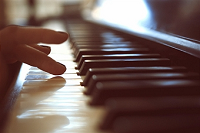
Home > Ear Training > Playing a Melody by Ear
|
||||
Playing a Melody by Ear
For comparison, many guitarists cannot read music at all, so learning songs by ear is a much more important skill. However, it is a useful skill to learn because many songs are not available as sheet music. The only way you can learn many songs, especially contemporary songs, is by ear. Initially, this can be a difficult skill, but it does become easier over time. When starting out, you are going to need a recording to learn to play a melody by ear. Eventually, you can reach a point where you can hear a melody once and play it, but that level of skill takes time to develop. A recording allows you to repeat specific sections as you try to learn the notes of the melody. You can use any music player to learn a song, but music transcription programs are the best choice. These programs allow you to easily play small snippets of the song repeatedly. In addition, most transcription programs can slow down the speed of the song, which can make learning a fast melody by ear much easier.
You do need to pick out one note in the melody so you can put the song in the correct key. Usually, you want to try to match the first note of the song exactly. If you are using a transcription program, you can just set it to continuously repeat the first note. At that point, you can hit keys on the piano until you find the exact match. Once you have the first note, you can use your relative pitch ability to learn the rest of the melody. At this point, you should try to pick out a small section, like the first bar or two of the melody. Listen to that section a couple of times and then try to match it. You have the first note, which gives you a starting point for playing a melody by ear. After that you should, to some extent, be able to instinctually start picking out the rest of the notes. It may take a few attempts at the melody, but you should be able to pick out all the notes of it. If you have trouble, try listening to the melody some more. In addition to helping you learn to play songs, learning to play melodies by ear has another benefit. Learning songs by ear helps to strengthen your ability to recognize the relative pitch of the note. Over time this allows you to more quickly learn songs using this technique. In addition, relative pitch is an important aspect of composition. The tone of notes in a song is determined by the relative pitch. If you are good at recognizing the relative pitch, you are going to be able to more easily gravitate to the notes you want to use when writing songs.
Check out Perfect Pitch Supercourse for the proven method of learning perfect pitch...
| ||||
|
Although every attempt has been made to make information as accurate as possible, we are not responsible for any errors that may appear.
 Learning to play a melody by ear is a skill that does not get emphasized
in some piano instruction. Most piano instruction follows a classic methodology, so learning to read music
notation is an important part of lessons.
Learning to play a melody by ear is a skill that does not get emphasized
in some piano instruction. Most piano instruction follows a classic methodology, so learning to read music
notation is an important part of lessons.
 Most piano players do not have
Most piano players do not have 



